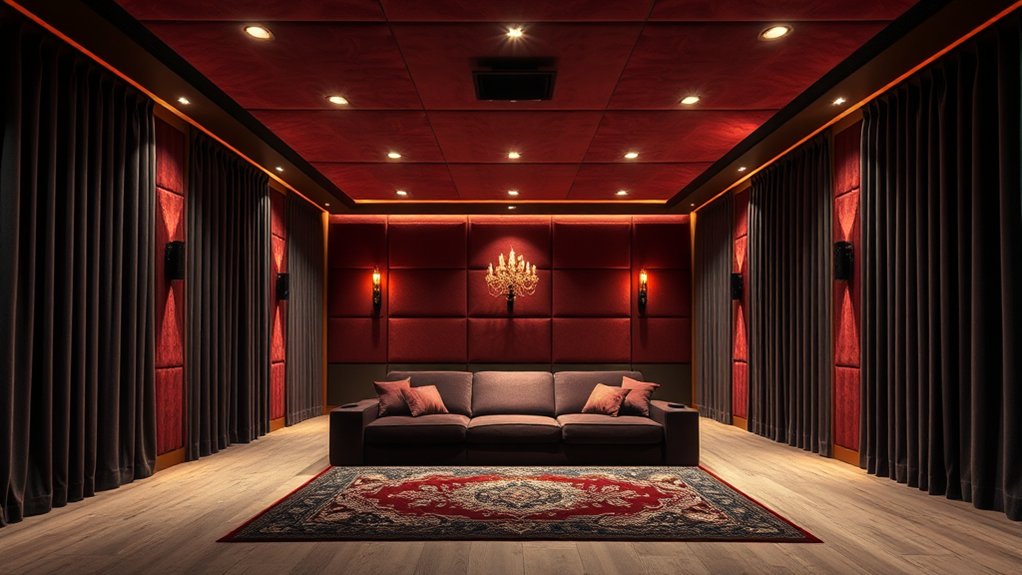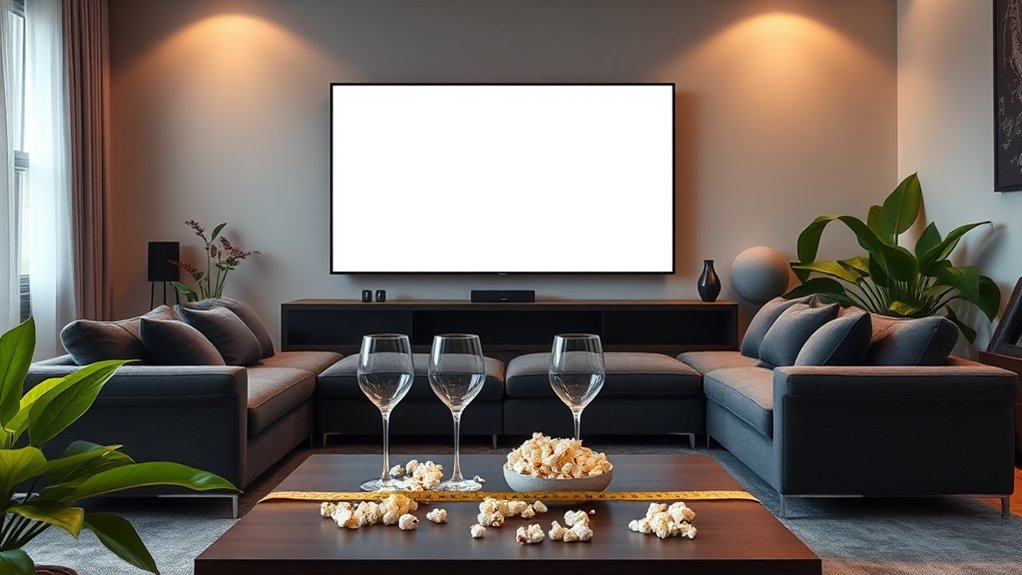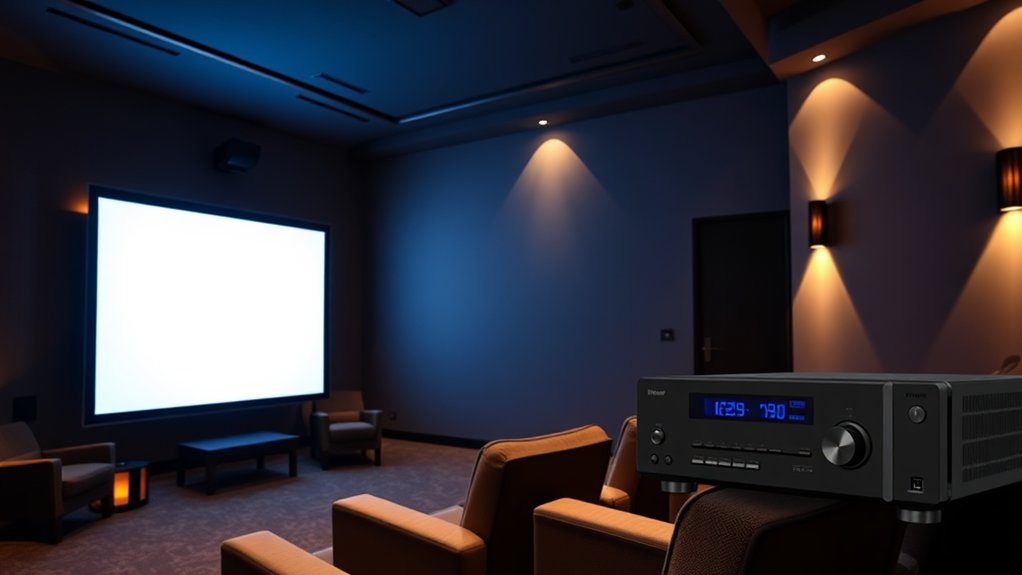Screen gain measures how effectively a screen reflects light, somewhat like a mirror but for images. If you’re in a brightly lit room, a higher gain can brighten your viewing, but you might spot distracting hotspots (annoying, right?). Conversely, in darker spaces, low gain helps maintain contrast but can wash out when viewed from angles. It’s essential you select the right gain based on your setup and audience. Stick around, and you’ll reveal more about optimizing your viewing experience!
Key Highlights
- Screen gain measures how much light a projection screen reflects compared to a standard reference, influencing brightness and viewing experience.
- A standard gain of 1.0 offers balanced brightness; values above increase brightness, while lower values may enhance contrast in darker environments.
- Higher gain screens can create distracting hotspots in well-lit rooms, while low gain screens aid in maintaining contrast for dark settings.
- Material and texture significantly impact gain; for example, gray screens improve contrast but reduce brightness compared to glass beaded or silver screens.
- Selecting the right screen gain is crucial for enhancing viewer experience, taking into account ambient light, audience size, and preferred viewing angles.
Understanding Screen Gain: The Basics
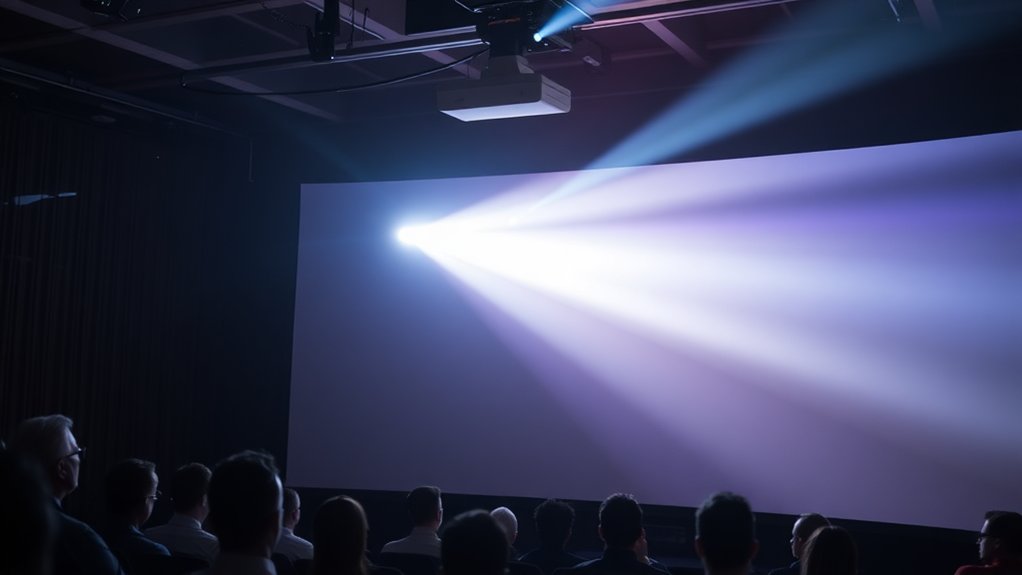
In relation to projecting your favorite movies or presentations, understanding screen gain is crucial, especially if you want the best possible picture quality.
Simply put, screen gain measures how much light a projector screen reflects compared to a standard white reference board. A gain of 1.0 reflects the same light as this board, whereas a gain above 1.0 means a brighter image, and below 1.0 indicates a dimmer one. These values range between zero and around 2.0. Gain standards are certified and help ensure that measurements are accurate and reliable. Additionally, the balance between gain and viewing angles is important, as higher gain may limit the optimal brightness to a narrower viewing area.
The texture and color of the screen affect its gain; for instance, a gray screen might lower the gain for better contrast.
How Screen Gain Affects Your Viewing Experience
Choosing the right screen gain can considerably shape how you experience movies, presentations, or video games.
If you’re in a bright room, a higher gain screen can amplify brightness, battling against ambient light like a superhero fighting dark forces. Nevertheless, you might find those hotspots distracting, like an annoying fly buzzing around during a vital scene. A higher screen gain can lead to brighter images, making it especially useful in environments flooded with light. High gain screens typically have reduced viewing angles, which may further limit your seating options.
Conversely, low gain screens excel in dark environments, preserving rich contrasts and color accuracy, but might leave viewers on the edges squinting at faded images.
Measuring Screen Gain: Standards and Methods
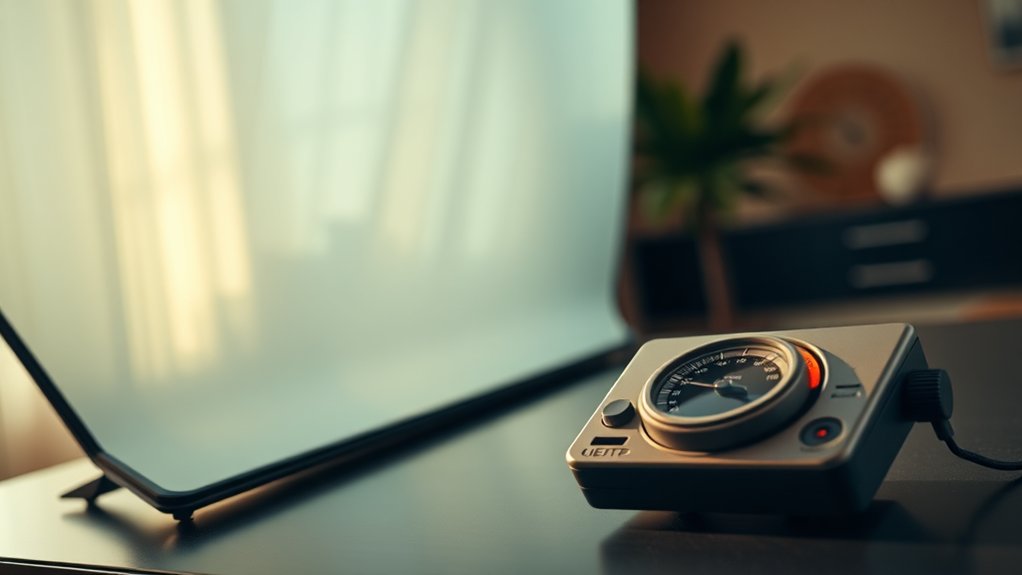
In relation to measuring screen gain, having a firm grasp of standards and methods is essential to guarantee accurate evaluations.
You’ll first compare your screen’s luminance to a standard reference, like a white magnesium oxide board, which has a gain value of 1.0. To achieve precise measurements, use a calibrated light meter, and illuminate the screen under controlled lighting to eliminate distractions.
Take readings at angles, particularly focusing on zero degrees for peak gain, and then assess the half-gain viewing angles to understand how brightness changes with position. Moreover, understanding screen gain can significantly influence your choice of projector screen and enhance your viewing experience.
The Role of Screen Material in Gain
Though understanding the measurement of screen gain is important, it’s likewise key to recognize how the material a screen is made from plays an integral role in determining that gain.
For instance, a matte white screen—your most common choice—offers a balanced gain of about 1.0, perfect for accurate color reproduction.
Conversely, glass beaded screens may have higher gains by reflecting light but can leave you squinting if you’re not directly in front of them.
Alternatively, Ambient Light Rejecting (ALR) screens strike a balance, rejecting unwanted light while preserving moderate gain.
In the end, the right material doesn’t just influence how bright your images are; it can transform your entire viewing experience, leaving you wondering why you didn’t upgrade sooner.
The Impact of Color on Screen Gain
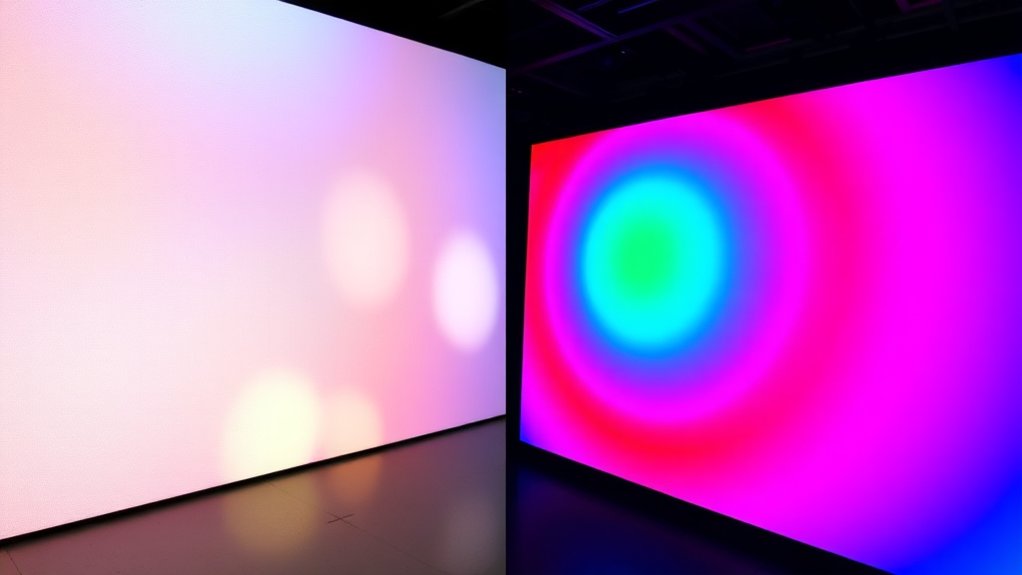
In relation to screen gain, the color of the screen can greatly alter how well your images pop on display, often leaving you wondering if you’ve inadvertently stepped into a paint shop rather than a projection room.
A white screen reflects light uniformly, offering a gain near 1.0 for natural brightness. At the same time, gray screens might reduce overall brightness while enhancing contrast, creating a depth that’s often missing in brighter environments.
A white screen provides uniform brightness, while gray screens enhance contrast and depth, perfect for bright environments.
You might think, “Would darker screens wash out my colors?” Not necessarily! They can deepen blacks and prevent that bothersome washed-out look.
Nevertheless, if you crave brightness and vivid colors, silver screens may tempt you, though be wary of hot spots!
In the end, choosing the right color balances brightness and contrast for best viewing.
Viewing Angles: How Gain Influences Brightness
Choosing the right screen is like selecting the perfect pair of sunglasses; you want something that improves your view without distorting reality.
When considering screen gain, keep in mind that it affects viewing angles considerably. Higher gain screens pack brightness directly in front but, oh boy, they can leave off-axis viewers in the dark. You see, as gain increases, the brightness falls dramatically at wider angles, creating that dreaded hotspot effect.
Alternatively, lower gain screens spread brightness more evenly, making them great for group settings. So, if your family’s all about movie night, a wider-angle low gain screen might be your best bet. After all, no one wants to squint through shadowy corners as they fight over the popcorn, right?
Ambient Light and Its Effect on Screen Gain
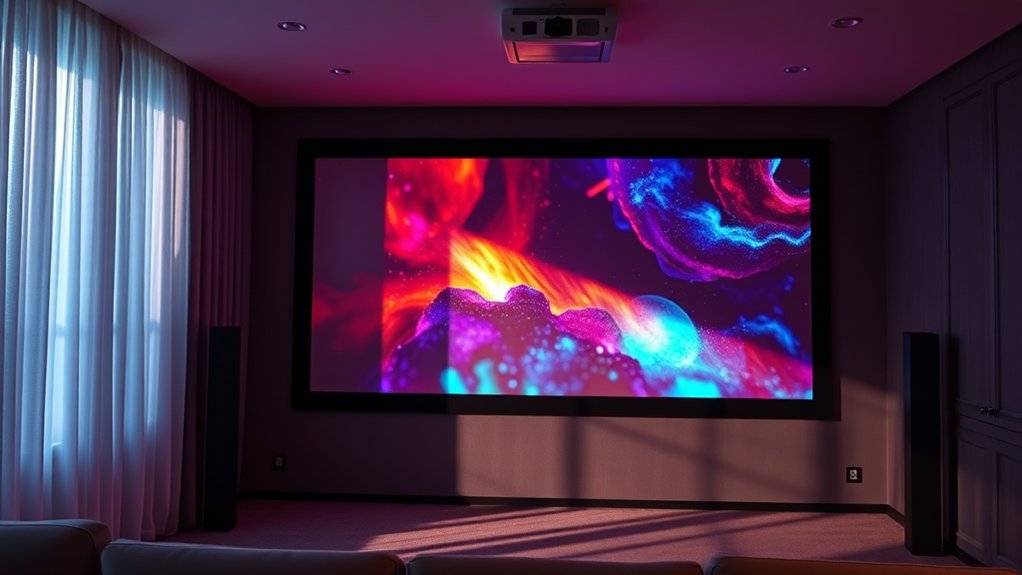
In regards to home theaters or presentation rooms, ambient light is the unwelcome guest that can dim your cinematic experience, causing shadows to creep onto the screen and details to fade away.
This troublesome light, whether from windows, overhead fixtures, or electronic devices, can raise the baseline brightness, making your carefully chosen content appear washed out.
To counter this effect, you’d ideally opt for higher gain screens or Ambient Light Rejecting (ALR) technology. These options can help reflect more light back to you, brightening your image and enhancing contrast.
Opt for higher gain screens or Ambient Light Rejecting technology to combat ambient light and enhance your viewing experience.
Conversely, if you choose lower gain screens, you risk losing clarity in those bright environments.
Trade-offs Between High and Low Gain Screens
Although ambient light can wreak havoc on your viewing experience, choosing the right screen gain can greatly improve or detract from that experience.
If you opt for a high gain screen, you’ll see brighter images directly in front, but those off to the side may face dimming or, worse, hotspotting—imagine a psychedelic disco ball effect ruining the mood!
On the flip side, low gain screens distribute light more evenly, providing wider viewing angles, so everyone on your couch gets a decent picture.
Nonetheless, they can compromise brightness in dim settings. Think of it as a balancing act: prioritize brightness with high gain, or enjoy consistent quality with low gain.
In the end, your choice depends on your environment and viewing preferences.
Choosing the Right Gain for Your Setup
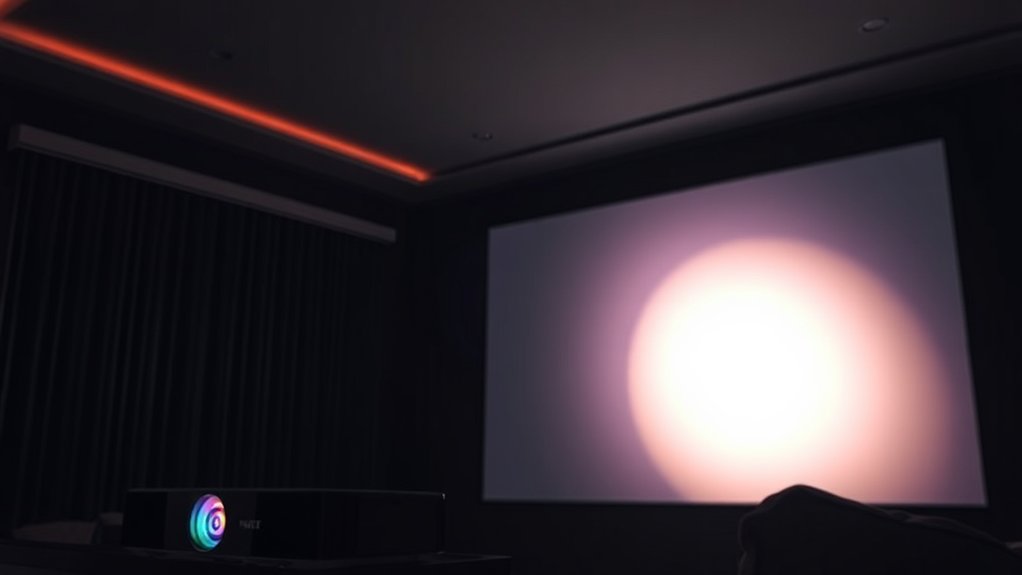
Even though you might be tempted to simply pick a screen based on its gain rating, it’s essential to evaluate how it aligns with your room’s specific lighting conditions and your projector’s capabilities.
For instance, if you’ve got a dark home theater, a low-gain screen (0.8-1.0) will keep colors accurate and guarantee wide viewing angles.
Conversely, moderately lit rooms may need a gain of 1.0-1.3 to strike a balance between brightness and decent viewing comfort.
If your projector isn’t the brightest, high-gain screens (1.3+) can help, but be wary of glare (nobody likes watching TV during squinting!).
In the end, choose screen gain that reflects your setup so you can enjoy crystal-clear images, not frustrating artifacts.
Practical Considerations for Screen Selection
Choosing the right screen gain isn’t just about the numbers; it’s about ensuring ideal performance tailored to your unique viewing environment.
You need to take into account factors like the screen material, which greatly impacts image quality. For instance, white matte screens work well in various settings, whereas gray ALR screens excel in bright rooms by enhancing contrast.
If you’re hosting a crowd, low-gain screens with broad viewing angles make sense; otherwise, high-gain screens might leave your viewers in the dark—figuratively speaking, of course.
Furthermore, it’s essential to match your screen gain with your projector’s brightness; otherwise, you’ll have uneven images that might drive you a bit nuts.
Testing under real conditions can save you from unwanted surprises. Happy viewing!
Frequently Asked Questions
Can Screen Gain Affect Image Color Accuracy?
Yes, screen gain can affect image color accuracy. When you choose a high gain screen, you might notice uneven brightness and color shifts, whereas low gain screens can improve contrast, enhancing overall fidelity in your projected images.
Are There Specific Projectors Best Suited for High Gain Screens?
If you’re using high gain screens, choose projectors with moderate to low brightness between 1500–3000 lumens. DLP and laser projectors work well too, ensuring sharper images and reducing hotspots for a superior viewing experience.
How Does Room Decor Influence Screen Gain Effectiveness?
Room decor greatly influences screen gain effectiveness. Light colors reflect more ambient light, reducing contrast, whereas darker tones absorb it, enhancing image quality. Align your decor choices with your screen gain for ideal viewing experiences.
What Are Common Misconceptions About Screen Gain?
You might think higher gain always means brighter images, but that’s not true. Furthermore, screens with gain below 1.0 aren’t poor quality. Always consider your specific setup rather than relying solely on gain numbers.
Does Screen Gain Impact Image Lifespan or Performance Over Time?
Screen gain doesn’t directly impact image lifespan or performance over time. Instead, factors like screen material, projector quality, and maintenance play vital roles in image stability and longevity, regardless of the screen’s gain level.


